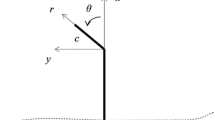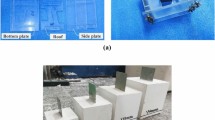Abstract
This paper studies the relationship between the two parameter fracture model and the size effect model. An equivalency between two models is first established based on infinitely large size specimens. Based on this equivalency, relationships between material fracture parameters (K sIc , CTODc) and (G f, cf) are derived. Using these relationships, values of (K sIc , CTODc) and (G f, cf) can be predicted from each other. It is found that the relationship betweenCTOD c andc f theoretically depends on both specimen geometry and initial crack length. However this dependency is numerically insignificant, except for tensile plate with a short center notch. The obtained results may explain why both the two parameter fracture model and the size effect model can reasonably predict fracture behavior of quasi-brittle materials.
Résumé
Dans cet article, on étudie la relation entre le modèle de fracture à deux paramètres et le modèle de l'effet de dimension. On établit tout d'abord une équivalence entre les deux modèles en se basant sur deux échantillons de dimension infiniment grande. En s'appuyant sur cette équivalence, on déduit les relations entre les paramètres de fracture des matériaux (K sIc , CTODc) et (Gf, cf). En utilisant ces relations, les valeurs de (K sIc , CTODc) et (Gf, cf) peuvent être déduites l'une de l'autre. On a trouvé que la relation entre CTODc et cf dépend théoriquement à la fois de la géométrie de l'échantillon et de la longueur initiale de la fissure. Toutefois, cette dépendance est numériquement non significative, excepté pour les plaques mises en traction avec une entaille centrale. Les résultats obtenus peuvent expliquer pourquoi à la fois le modèle de fracture à deux paramètres et le modèle de l'effet de dimension peuvent prévoir de façon raisonnable le comportement à la rupture de matériaux quasi-fragiles.
Similar content being viewed by others
References
Hillerborg, A., Modeer, M. and Peterson, P.E., ‘Analysis of Crack Formation and Crack Growth in Concrete by Means of Fracture Mechanics and Finite Elements,’Cement and Concrete Research, V 6, No. 6, (1976), 773–782.
Bažant, Z.P., Oh, B.H., ‘Crack Band Theory for Fracture of Concrete,’Materials and Structures,16 (1983), 155–177.
Jenq, Y.S. and Shah, S.P., ‘A Two Parameter Fracture Model for Concrete,’Journal Engineering Mechanics,111, 4, (1985), 1227–1241.
Bažant, Z.P. and Kazemi, M.T., ‘Determination of Fracture Energy, Process Zone Length and Brittleness Number from Size Effect, with Application to Rock and Concrete,’International Journal of Fracture,44, 2 (1990), 111–131.
Nallathambi, P. and Karihaloo, B.L., ‘Determination of Specimen-Size Independent Toughness of Plain Concrete,’Magazine of Concrete Research,38, 135, (1986), 67–76.
Swartz, S.E. and Refai, T.M.E., ‘Influence of Size Effects on Opening Mode Fracture Parameters for Precracked Concrete Beams in Bending,’ Fracture of Concrete and Rock, Springer-Verlag, New York, (1988), 243–254.
RILEM Committee on Fracture Mechanics of Concrete-Test Methods, ‘Determination of the Fracture of Mortar and Concrete by Means of Three-Point Bend Tests on Notched Beams,’Materials and Structures,18, 106, (1985), 285–290.
RILEM Committee on Fracture Mechanics of Concrete-Test Methods, ‘Determination of the Fracture Parameters (K sIc andCTOD c) of Plain Concrete Using Three-Point Bend Tests,’Materials and Structures,23, 138, (1990), 457–460.
RILEM Committee on Fracture Mechanics of Concrete-Test Methods, ‘Size-effect Method for Determining Fracture Energy and Process Zone Size of Concrete,’ Materials and Structures, 23, (1990), 461–465.
Elices, M. and Planas, J., ‘Size Effect and Experimental Validation of Fracture Models,’ Analysis of Concrete by Fracture Mechanics, edited by Elfgren, L. and Shah, S.P., Chapman and Hall, London, (1991), 99–127.
Bažant, Z.P., Gettu, R. and Kazemi, M.T., ‘Identification of Nonlinear Fracture Properties from Size Effect Tests and Structural Analysis Based on Geometry-Dependent R-Curves,’International Journal of Rock Mechanics and Mineral Science,28, 1, (1991), 43–51.
Tada, H., Paris, P.C. and Irwin, G.R., ‘The Stress Analysis of Cracks Handbook,’ 2nd Ed., Paris Productions, St. louis, USA, (1985).
Karihaloo, B.L. and Nallathambi, P., ‘Notched Beam Test: Mode I Fracture Toughness,’ Fracture Mechanics Test Method for Concrete, RILEM Report 5, Edited by Shah, S.P. and Carpinteri, A., Chapman and Hall, London, (1991), 1–86.
Bažant, Z.P. and Pfeiffer, P.A., ‘Determination of Fracture Energy from Size Effect and Brittleness Number,’ACI Materials Journal,84, 6, (1987), 463–480.
Author information
Authors and Affiliations
Additional information
Editorial note Prof. S.P. Shah has long been involved in RILEM activities. As a young researcher, he was awarded one of the first RILEM Metals, in 1982. Then he participated in the TCs dealing with fracture mechanics (89-FMT and 90-FMA), chairing 89-FMT and editing the final report issued by the latter TC. Now, he is chairman of TC 148 on strain softening response of concrete. Prof. S.P. Shah was appointed RILEM Fellow in 1994.
Rights and permissions
About this article
Cite this article
Ouyang, C., Tang, T. & Shah, S.P. Relationship between fracture parameters from two parameter fracture model and from size effect model. Mat. Struct. 29, 79–86 (1996). https://doi.org/10.1007/BF02486197
Published:
Issue Date:
DOI: https://doi.org/10.1007/BF02486197




